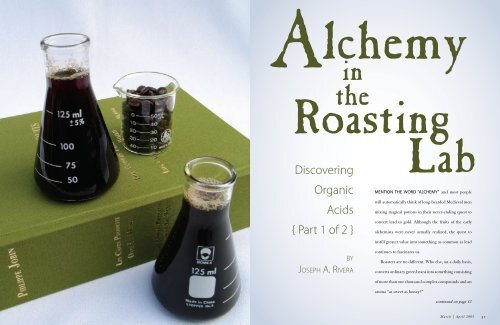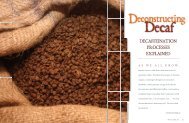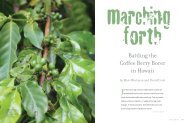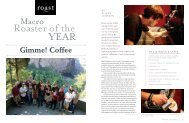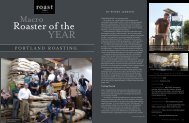Organic AcidsâAlchemy in the Roasting Lab - Roast Magazine
Organic AcidsâAlchemy in the Roasting Lab - Roast Magazine
Organic AcidsâAlchemy in the Roasting Lab - Roast Magazine
You also want an ePaper? Increase the reach of your titles
YUMPU automatically turns print PDFs into web optimized ePapers that Google loves.
Alchemy<br />
<strong>in</strong><br />
<strong>the</strong><br />
<strong>Roast</strong><strong>in</strong>g <strong>Lab</strong><br />
Discover<strong>in</strong>g<br />
<strong>Organic</strong><br />
Acids<br />
{ Part 1 of 2 }<br />
Mention <strong>the</strong> word “alchemy” and most people<br />
will automatically th<strong>in</strong>k of long-bearded Medieval men<br />
mix<strong>in</strong>g magical potions <strong>in</strong> <strong>the</strong>ir never-end<strong>in</strong>g quest to<br />
convert lead to gold. Although <strong>the</strong> fruits of <strong>the</strong> early<br />
alchemists were never actually realized, <strong>the</strong> quest to<br />
<strong>in</strong>still greater value <strong>in</strong>to someth<strong>in</strong>g as common as lead<br />
by<br />
Jo s e p h A. Ri ver a<br />
cont<strong>in</strong>ues to fasc<strong>in</strong>ates us.<br />
<strong>Roast</strong>ers are no different. Who else, on a daily basis,<br />
converts ord<strong>in</strong>ary green beans <strong>in</strong>to someth<strong>in</strong>g consist<strong>in</strong>g<br />
of more than one thousand complex compounds and an<br />
aroma “as sweet as honey?”<br />
cont<strong>in</strong>ued on page 32<br />
30 roast March | April 2005 31
Alchemy <strong>in</strong> <strong>the</strong> roast<strong>in</strong>g lab ( cont<strong>in</strong>ued)<br />
But <strong>the</strong> idea of turn<strong>in</strong>g lead <strong>in</strong>to gold is not so far-fetched,<br />
s<strong>in</strong>ce, accord<strong>in</strong>g to <strong>the</strong> First Law of Thermodynamics, “matter<br />
is nei<strong>the</strong>r created nor destroyed, but simply changes form.” In<br />
this article, we’ll explore <strong>the</strong> basics of coffee chemistry and<br />
discover some of <strong>the</strong> wonderful magic that occurs with<strong>in</strong><br />
those t<strong>in</strong>y beans and <strong>in</strong> <strong>the</strong> laboratories of thousands of<br />
roasters every day.<br />
Raw Materials<br />
Coffee plants, much like humans, produce hundreds of<br />
byproducts through <strong>the</strong>ir metabolic life, each term<strong>in</strong>at<strong>in</strong>g<br />
<strong>in</strong> <strong>the</strong> formation of organic acids and o<strong>the</strong>r <strong>in</strong>termediate<br />
compounds. (In layman’s terms, “organic acids” are any acids<br />
that conta<strong>in</strong> a carbon <strong>in</strong> <strong>the</strong>ir molecular structure.)<br />
Coffee plants, via <strong>the</strong> Calv<strong>in</strong> cycle, produce more than a<br />
dozen different acid <strong>in</strong>termediates, all of which rema<strong>in</strong> locked<br />
<strong>in</strong>side <strong>the</strong> bean at harvest. Variables such as genetics, varietals<br />
and species ultimately determ<strong>in</strong>e <strong>the</strong> sugar production that<br />
is “locked <strong>in</strong>side” <strong>the</strong> beans. For example, <strong>the</strong> species Coffea<br />
arabica conta<strong>in</strong>s almost twice <strong>the</strong> concentration of sucrose<br />
as its Coffea robusta counterpart. As we’ll discuss later, <strong>the</strong>se<br />
sugars play a critical role to <strong>the</strong> development of acidity <strong>in</strong><br />
<strong>the</strong> cup. Sugars, be<strong>in</strong>g heat-labile, decompose dur<strong>in</strong>g <strong>the</strong><br />
roast<strong>in</strong>g process to create more than 30 organic acids and<br />
hundreds of volatile compounds.<br />
Though genetics play a key role <strong>in</strong> what sugars are<br />
ultimately produced, it would be premature to conclude<br />
that this is <strong>the</strong> only variable that affects quality. To fully<br />
explore <strong>the</strong> magic that occurs <strong>in</strong> <strong>the</strong> bean, one must look<br />
at altitude and microclimate, yet ano<strong>the</strong>r example of <strong>the</strong><br />
classic nature vs. nurture paradox.<br />
On <strong>the</strong> physical level, altitude has <strong>the</strong> effect of<br />
<strong>in</strong>creas<strong>in</strong>g both bean size and bean density. With <strong>the</strong><br />
help of a screen sorter, you can quickly confirm this, such<br />
that many countries rate coffee quality based on screen<br />
size. The effect makes sense, s<strong>in</strong>ce at cooler temperatures<br />
reactions rates decrease and <strong>the</strong> plant effectively has more<br />
“time” to pack nutrients and sugars <strong>in</strong>to <strong>the</strong> beans.<br />
Altitude also has <strong>the</strong> effect of chang<strong>in</strong>g not only<br />
physical parameters, but of alter<strong>in</strong>g chemical composition<br />
as well. At higher altitudes we tend to produce coffees<br />
higher <strong>in</strong> perceived acidity. Such that for every 100<br />
meters ga<strong>in</strong>ed <strong>in</strong> altitude we can expect a 0.60 ° C drop<br />
<strong>in</strong> temperature, and for every 300 meters, a 10 percent<br />
<strong>in</strong>crease sugar production, namely sucrose. What does all<br />
this mean? Higher acidity!<br />
But <strong>the</strong> puzzle doesn’t end here. For if altitude<br />
cont<strong>in</strong>ued on page 34<br />
Free Info #155<br />
Free Info #152<br />
32 roast March | April 2005 33
Alchemy <strong>in</strong> <strong>the</strong> roast<strong>in</strong>g lab ( cont<strong>in</strong>ued)<br />
determ<strong>in</strong>es how much acidity<br />
is produced, <strong>the</strong>n regional<br />
humidity determ<strong>in</strong>es <strong>the</strong> type of<br />
acid produced. It is not just how<br />
much acid is produced, but what<br />
type, that effectively def<strong>in</strong>es<br />
<strong>the</strong> acidity profile of a certa<strong>in</strong><br />
coffee. This is easy to see when<br />
cupp<strong>in</strong>g any one of <strong>the</strong> seven<br />
regional coffees <strong>in</strong> Guatemala.<br />
Anyone who has ever cupped<br />
an Antigua or Huhuetenango<br />
alongside a Coban can attest<br />
to a pronounced difference. To<br />
those not familiar with Coban,<br />
it is one of <strong>the</strong> most humid<br />
regions <strong>in</strong> Guatemala, at times<br />
resembl<strong>in</strong>g a ra<strong>in</strong>forest. In <strong>the</strong><br />
cup, many would say <strong>the</strong> Coban<br />
cups with a delicate fruit<strong>in</strong>ess or<br />
w<strong>in</strong>eyness as compared to <strong>the</strong><br />
o<strong>the</strong>r regions <strong>in</strong> Guatemala. As it<br />
turns out, <strong>the</strong> regional humidity<br />
has <strong>the</strong> effect of <strong>in</strong>creas<strong>in</strong>g <strong>the</strong><br />
“fruity acids” <strong>in</strong> <strong>the</strong> bean, much<br />
like <strong>the</strong> fruit<strong>in</strong>ess of chardonnay w<strong>in</strong>es. This would suggest<br />
that humidity <strong>in</strong>creases <strong>the</strong> level of malic acid, though I have<br />
not seen published studies on this.<br />
For countries that lack <strong>the</strong> topographical elevation<br />
necessary to maximize <strong>the</strong> beans’ potential, shade plays an everimportant<br />
role. For what is not achieved through altitude can<br />
be made up, with<strong>in</strong> reasonable limits, by proper shad<strong>in</strong>g. The<br />
goal is to slow down <strong>the</strong> metabolic rate of <strong>the</strong> plant, <strong>in</strong>crease<br />
sugar production and, ultimately, improve cup quality.<br />
Although <strong>the</strong>re are more than one thousand compounds<br />
produced dur<strong>in</strong>g roast<strong>in</strong>g, by far <strong>the</strong> most important when<br />
deal<strong>in</strong>g with cup profile are <strong>the</strong> organic acids. As we embark on<br />
this brief journey, we’ll explore <strong>the</strong> science beh<strong>in</strong>d <strong>the</strong> scenes.<br />
Let’s beg<strong>in</strong> <strong>the</strong> journey…<br />
Chlorogenic Acids (CGA)<br />
No explanation of organic acids would be complete without a<br />
thorough discussion of chlorogenic acids (CGA). As seen from<br />
Figure 1, CGA accounts for <strong>the</strong> majority of <strong>the</strong> organic acid<br />
concentration <strong>in</strong> coffee, account<strong>in</strong>g for six to seven percent for<br />
arabica and up to 10 percent <strong>in</strong> robusta on a dry basis. Although<br />
it may not appear to be much, <strong>the</strong> relative content of CGA<br />
compared to that of caffe<strong>in</strong>e is seven to eight times higher. And<br />
<strong>in</strong> a typical eight-ounce cup of coffee, CGA represents roughly<br />
two ounces, or an estimated 30 percent by volume.<br />
Dur<strong>in</strong>g roast<strong>in</strong>g, CGA plays an important role <strong>in</strong> <strong>the</strong><br />
development of coffee flavors. Almost half of <strong>the</strong> CGA content<br />
is decomposed <strong>in</strong> a medium roast, whereas French roasts<br />
can exhibit up to an 80 percent loss. The portion that does<br />
decompose is used <strong>in</strong> <strong>the</strong> production of qu<strong>in</strong>ic acid and flavor<br />
precursors.<br />
It should be mentioned that chlorogenic acid does not<br />
refer to a s<strong>in</strong>gle compound, but ra<strong>the</strong>r a family of more than<br />
six different isomers of <strong>the</strong> acids, each with different flavor<br />
attributes. Without gett<strong>in</strong>g too technical, <strong>the</strong>re are basically two<br />
families of <strong>the</strong>se acids; mono-caffeoyl and di-caffeoyl. While<br />
mono-caffeoyl acids readily decompose dur<strong>in</strong>g roast<strong>in</strong>g, those<br />
of <strong>the</strong> di-caffeoyl family rema<strong>in</strong> almost unchanged and have<br />
been reported to impart a metallic-bitter taste. It’s no surprise<br />
<strong>the</strong>n that robustas, which exhibit a similar metallic taste,<br />
conta<strong>in</strong> a larger concentration of <strong>the</strong>se acids than <strong>the</strong>ir arabica<br />
counterparts. It has even been suggested that due to <strong>the</strong>ir<br />
undesirable taste, CGAs have effectively been used by plants<br />
for protection from animal and <strong>in</strong>sect <strong>in</strong>festation. Perhaps<br />
those pesty bugs do know a th<strong>in</strong>g or two about specialty-grade<br />
coffee!<br />
At just past <strong>the</strong> second crack, <strong>the</strong>se di-caffeoyl acids<br />
decompose and <strong>the</strong> metallic-bitter taste slowly dim<strong>in</strong>ishes,<br />
though a few savvy chemists at soluble factories have effectively<br />
been able to slightly alter <strong>the</strong> levels of <strong>the</strong>se acids through steam<br />
treatment of lower quality green beans. Who would have ever<br />
thought of such a th<strong>in</strong>g? I guess necessity is truly <strong>the</strong> mo<strong>the</strong>r<br />
of <strong>in</strong>vention.<br />
cont<strong>in</strong>ued on page 36<br />
Free Info #102<br />
Free Info #158<br />
34 roast March | April 2005 35
Alchemy <strong>in</strong> <strong>the</strong> roast<strong>in</strong>g lab ( cont<strong>in</strong>ued)<br />
Decomposition of CGA leads to<br />
<strong>the</strong> production of two very important<br />
components. As seen <strong>in</strong> Figure 2, <strong>the</strong><br />
decomposition of CGA causes a steady<br />
<strong>in</strong>crease <strong>in</strong> caffeic and qu<strong>in</strong>ic acid, both of<br />
which are classified as phenolic compounds.<br />
Such compounds are often astr<strong>in</strong>gent <strong>in</strong><br />
nature, thus darker roasts tend to produce<br />
coffees higher <strong>in</strong> astr<strong>in</strong>gency and body. The<br />
same pr<strong>in</strong>ciple is seen when we compare <strong>the</strong><br />
body and astr<strong>in</strong>gency of a red w<strong>in</strong>e, such as<br />
a cabernet, to that of a chardonnay. As a rule<br />
of thumb, any naturally occurr<strong>in</strong>g substance<br />
that exhibits color will always conta<strong>in</strong> a<br />
large concentration of chromophores, a<br />
class of colored phenolic compounds.<br />
Recently, CGA has also been suggested<br />
as <strong>the</strong> ma<strong>in</strong> culprit for people suffer<strong>in</strong>g<br />
from acid reflux. It’s been estimated<br />
that as little as 200 mg. of CGA can<br />
<strong>in</strong>crease levels of HCl <strong>in</strong> <strong>the</strong> stomach.<br />
A typical cup of coffee yields anywhere<br />
between 15 and 325 mg. of CGA, well<br />
with<strong>in</strong> <strong>the</strong> suggested range. Those<br />
dr<strong>in</strong>k<strong>in</strong>g decaffe<strong>in</strong>ated do benefit,<br />
as <strong>the</strong> decaffe<strong>in</strong>ation process results<br />
<strong>in</strong> a slight decrease of CGA content.<br />
But it should be noted that <strong>the</strong> <strong>in</strong>itial<br />
<strong>in</strong>crease <strong>in</strong> stomach acidity is due<br />
solely to CGA and not caffe<strong>in</strong>e as<br />
many are lead to believe.<br />
CGAs: Qu<strong>in</strong>ic and Caffeic<br />
Before <strong>the</strong> first crack, CGA<br />
cont<strong>in</strong>ues to decompose, while<br />
qu<strong>in</strong>ic acid progressively <strong>in</strong>creases<br />
<strong>in</strong> concentration. Be<strong>in</strong>g a phenolic<br />
compound, qu<strong>in</strong>ic acid also<br />
proportionally <strong>in</strong>creases body and<br />
astr<strong>in</strong>gency and forms colored<br />
compounds, namely melanoid<strong>in</strong>s.<br />
Interest<strong>in</strong>gly, <strong>in</strong>creases <strong>in</strong> qu<strong>in</strong>ic<br />
acid concentration have been<br />
documented <strong>in</strong> cases where green<br />
coffee is stored for an extended period<br />
of time <strong>in</strong> warehouses, at times up<br />
to 1.5 percent dry basis. Luckily, one<br />
does not need to wait months to see<br />
<strong>the</strong> immediate affects on acidity, as it<br />
can be demonstrated <strong>in</strong> any cupp<strong>in</strong>g<br />
lab. As most of us have experienced<br />
while cupp<strong>in</strong>g, <strong>the</strong> longer we leave<br />
out a coffee liqueur while cool<strong>in</strong>g,<br />
<strong>the</strong> greater its perceived acidity. Why<br />
this happens is only one part of <strong>the</strong><br />
fasc<strong>in</strong>at<strong>in</strong>g chemistry that occurs <strong>in</strong><br />
our morn<strong>in</strong>g cup of joe.<br />
At roast levels exceed<strong>in</strong>g 6.5<br />
percent dry basis—roughly c<strong>in</strong>namon<br />
roast—we beg<strong>in</strong> to see <strong>the</strong> formation<br />
of qu<strong>in</strong>ide, <strong>the</strong> same compound<br />
commonly found <strong>in</strong> tonic water. As<br />
this compound rema<strong>in</strong>s <strong>in</strong> <strong>the</strong> hot<br />
<strong>in</strong>fusion, it slowly hydrolyzes back to<br />
qu<strong>in</strong>ic acid and serves to <strong>in</strong>crease <strong>the</strong><br />
level of perceived sourness. Thus, with<br />
dozens of reactions <strong>in</strong>visibly tak<strong>in</strong>g<br />
place <strong>in</strong> <strong>the</strong> cup, it truly makes cupp<strong>in</strong>g<br />
an extremely difficult time-dependent<br />
exercise. Away from <strong>the</strong> cupp<strong>in</strong>g lab,<br />
<strong>the</strong> effect is also seen when coffee has<br />
been left sitt<strong>in</strong>g on a heat<strong>in</strong>g element<br />
for an extended period of time. This<br />
is all too common dur<strong>in</strong>g long road trips, when we’re welcomed<br />
at <strong>the</strong> nearest highway coffee shop with sour coffee, and when we<br />
hear stories of unscrupulous coffee shop managers leav<strong>in</strong>g <strong>the</strong>ir<br />
coffee on <strong>the</strong> heat<strong>in</strong>g pan for up to eight hours on end, only to serve<br />
it “fresh” to you. Unfortunately, <strong>the</strong>re is no magic potion to prevent<br />
this reaction, and we’re once aga<strong>in</strong> rem<strong>in</strong>ded of <strong>the</strong> importance of<br />
coffee freshness.<br />
Ano<strong>the</strong>r one of CGA’s byproduct is caffeic acid. It is also a<br />
phenolic compound and one that will contribute slightly to cup<br />
astr<strong>in</strong>gency. Recently, caffeic acid has been documented to be a<br />
cont<strong>in</strong>ued on page 38<br />
Free Info #143<br />
Free Info #106<br />
36 roast March | April 2005 37
Alchemy <strong>in</strong> <strong>the</strong> roast<strong>in</strong>g lab ( cont<strong>in</strong>ued)<br />
potent antioxidant and believed to<br />
prevent <strong>the</strong> onset of several human<br />
cancers.<br />
Citric Acid<br />
Second on our list is citric acid.<br />
Occurr<strong>in</strong>g naturally as part of <strong>the</strong><br />
plant’s metabolism, citric acid<br />
follows CGA <strong>in</strong> concentration levels.<br />
Unlike many o<strong>the</strong>r acids, citric acid<br />
is not produced dur<strong>in</strong>g <strong>the</strong> roast<strong>in</strong>g<br />
process, but it is slowly decomposed.<br />
At n<strong>in</strong>e percent weight loss, we<br />
beg<strong>in</strong> to see <strong>the</strong> concentration slowly<br />
dim<strong>in</strong>ish. A medium-roasted coffee<br />
will conta<strong>in</strong> 50 percent less citric<br />
acid as compared to its green bean<br />
state. Citric acid’s effect on perceived<br />
acidity is significant, as it is one of<br />
<strong>the</strong> major acids contribut<strong>in</strong>g to cup<br />
profile. However, citric acid is not<br />
an acid you would like to have <strong>in</strong><br />
high concentrations, as most people<br />
describe its taste as acerbic and <strong>in</strong>tensely sour. So <strong>in</strong>tense is its<br />
characteristic sourness, that many candy<br />
manufacturers use it <strong>in</strong> <strong>the</strong> production<br />
of gelat<strong>in</strong>-based confections.<br />
But one needs to look a little fur<strong>the</strong>r<br />
to understand why this is so. Ever bitten<br />
<strong>in</strong>to a unripe orange? Describe its taste?<br />
Dur<strong>in</strong>g early maturation, fruits tend to<br />
produce a large concentration of organic<br />
acids, but as maturation cont<strong>in</strong>ues, <strong>the</strong>se<br />
same acids are converted <strong>in</strong>to sugars.<br />
Wait a couple days and that same unripe<br />
orange will taste significantly sweeter.<br />
Any roaster who has ever received a<br />
shipment of green coffee only to f<strong>in</strong>d it<br />
cup sour has experienced this firsthand.<br />
Fortunately, roasters can use this bit<br />
of <strong>in</strong>formation to verify <strong>the</strong> quality<br />
of post-harvest separation at orig<strong>in</strong>.<br />
Be<strong>in</strong>g a processed-controlled defect,<br />
poor separation of unripe beans will<br />
always elevate levels of this citric acid<br />
along with a correspond<strong>in</strong>g sourness. So<br />
what should a roaster do if he’s unable<br />
to return a sour lot of coffee? Quite<br />
simply… roast darker! This will drive off as much citric acid as<br />
possible.<br />
While this article only offers a<br />
glimpse <strong>in</strong>to <strong>the</strong> magic that occurs <strong>in</strong><br />
<strong>the</strong> roast<strong>in</strong>g lab, I hope it expanded<br />
your m<strong>in</strong>d and <strong>in</strong>troduced you to <strong>the</strong><br />
wonderful world of chemistry that<br />
occurs with<strong>in</strong> those t<strong>in</strong>y beans.<br />
In Part 2, we’ll look at <strong>the</strong> role of<br />
<strong>the</strong> rest of <strong>the</strong> important organic acids:<br />
acetic, malic and phosphoric acid. We’ll<br />
discuss how <strong>the</strong>se acids are formed,<br />
how <strong>the</strong>y are affected by wet process<strong>in</strong>g<br />
and how <strong>the</strong>y ultimately change dur<strong>in</strong>g<br />
roast<strong>in</strong>g.<br />
Joseph A. Rivera holds a degree<br />
<strong>in</strong> food chemistry and is <strong>the</strong> SCAA’s<br />
resident coffee scientist. His passion<br />
for coffee chemistry led to <strong>the</strong> creation<br />
of a site dedicated to coffee science,<br />
www.coffeechemistry.com. His e-mail<br />
address is jrivera@coffeechemistry.com.<br />
Free Info #165 Free Info #171<br />
Free Info #139<br />
38 roast March | April 2005 39


